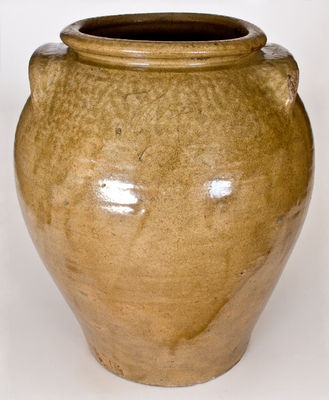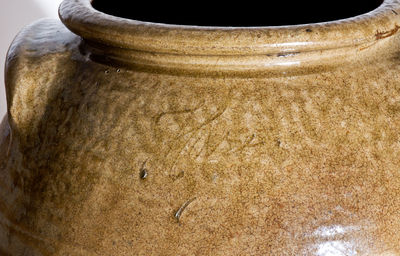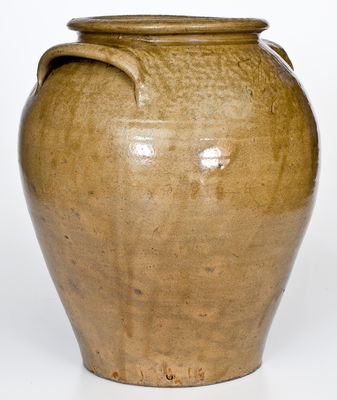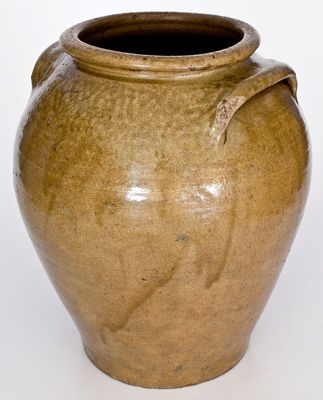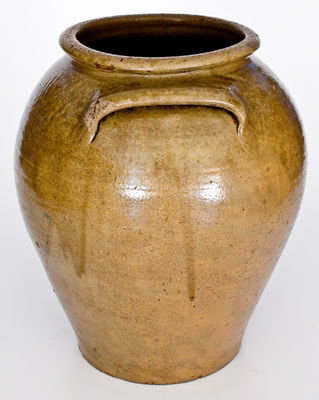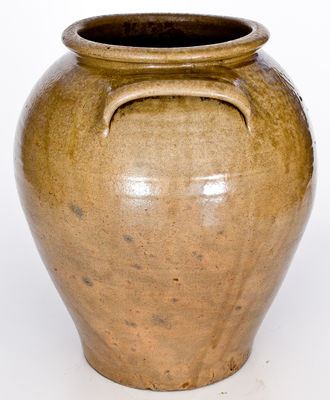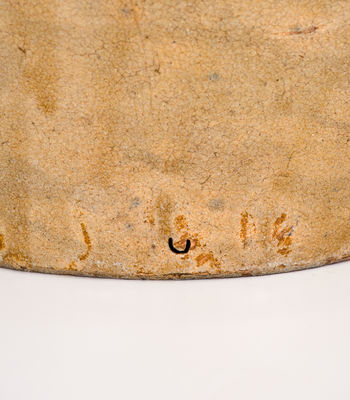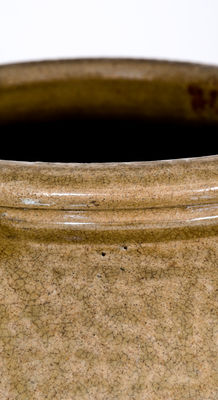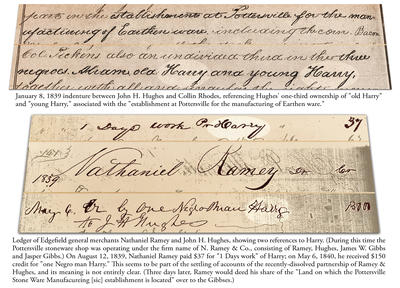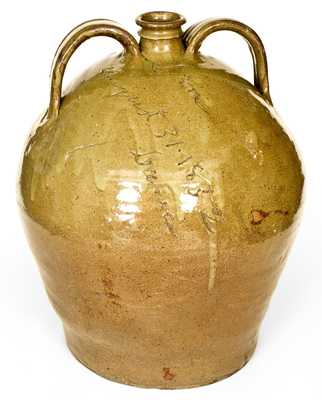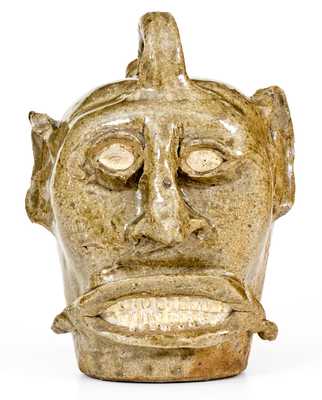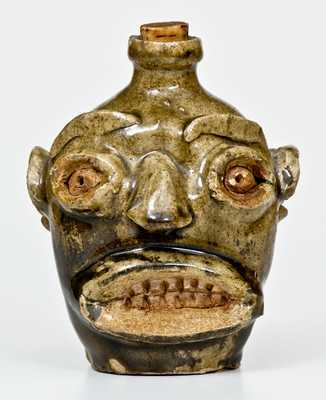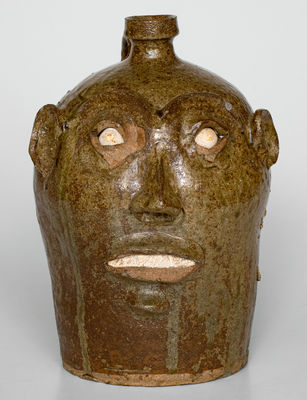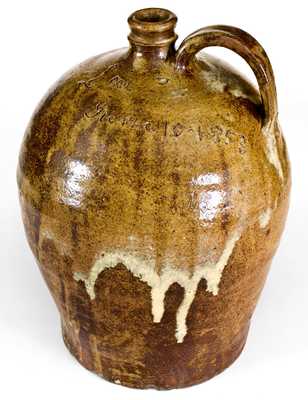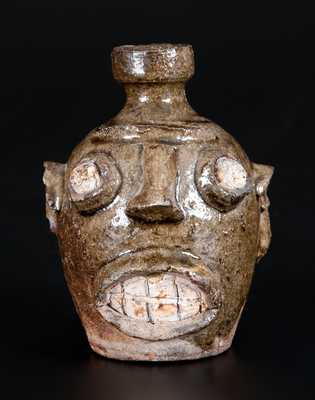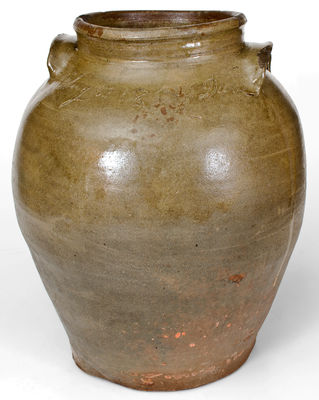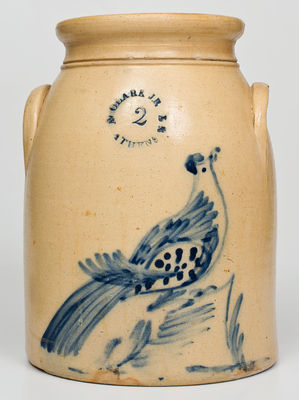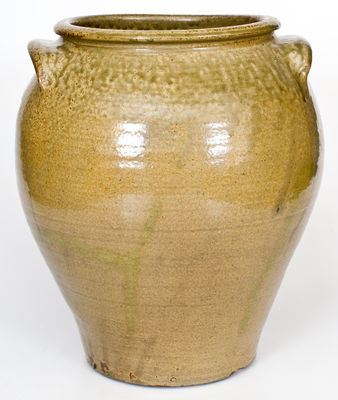Exceedingly Rare and Important Four-Gallon Alkaline-Glazed Stoneware Jar, Incised "Harry," Harry at the Pottersville Stoneware Manufactory, Edgefield District, SC, circa 1839-1843, ovoid jar with narrow base, swelled shoulder, semi-rounded, and dense lug handles with rounded edges, the surface covered in a light-olive alkaline glaze with darker runs cascading from the shoulder. Incised on the front shoulder with the script signature, "Harry," along with four punctates indicating four gallons. Base impressed with a small C or horseshoe stamp. This recently-surfaced jar is one of two known examples bearing the incised signature of enslaved African-American potter, Harry. Harry is remarkably well-documented in the historical record as a "turner" at the prolific Pottersville Stoneware Manufactory founded circa 1815 by Abner Landrum. As the founding stoneware shop of the Edgefield pottery tradition and the one credited with introducing alkaline glaze to the United States, it is difficult to overstate its importance to the development of America's ceramic craft as a whole. Pottersville is meanwhile the shop that began the career of Dave, whose name appears in an 1818 mortgage associated with the manufactory in a manner similar to the pictured documents referencing Harry. Harry first appears in a January 1839 indenture between well-known Edgefield potter Collin Rhodes and John H. Hughes, a man who took over Rhodes' share of an interest in Pottersville. This document references both an "old Harry" and a "young Harry" associated with the operation; whether the "Harry" of this jar is the older or younger Harry is up to speculation, but documents soon show a single Harry working as a key potter at Pottersville: August 1839 and May 1840 references to Harry appear in the ledger of the aforementioned Hughes and Nathaniel Ramey, partners in the Pottersville Stoneware Manufactory as well as a local general merchant concern. In November 1840, James W. Gibbs sold Jasper Gibbs three-fourths of his ownership of Harry, along with other shares of Pottersville property, the pair also being partners in the shop at that time. A March 1842 mortgage again references Harry in association with the Pottersville Stoneware Manufactory; as in previous documents, it identifies other enslaved workers at the pottery, in this case Abram and Daniel (fellow turners with Harry) and "old Tom" (a wagoner). A notice in the Edgefield Advertiser dated February 21, 1843 is the last identifiable reference in the historical record to Harry. In it, Jasper Gibbs & Co. announced that the firm would be selling at auction "our entire Pottersville property ... consisting of four Negroes, viz. three Turners and one Wagoner" along with a "stock of Stone Ware" and other property. (The Pottersville shop was acquired by future Governor of South Carolina Francis W. Pickens sometime circa 1844-1850 under whose ownership, according to Cinda K. Baldwin's Great & Noble Jar, "the operation evidently declined.") This jar's monumental discovery reveals a second literate enslaved potter in Edgefield who signed his ware. (A few extremely rare collaborative works by Dave and other slaves bear both potters' signatures in Dave's hand. One of these, now existing as a sherd from the Stoney Bluff site, reads "Dave & Abram," probably the aforementioned Abram who worked alongside Harry.) The distinctive potting of this jar has already led to the firm attribution of an unsigned jar in Crocker Farm's Spring 2021 auction to Harry's hand. Both jars feature a confidently-potted form with wide shoulder and mouth, narrow rim, punctates, and an impressed C or horseshoe mark. Most distinctive about both jars is the handle construction; the handles are thicker, flatter, and closer to the body of the jar than Dave's handles, and include a rounded edge. It is these handles, we believe, that will serve as a clear diagnostic trait in determining future works by Harry. As both Harry and Dave worked at Pottersville, intriguing theories abound regarding possible influences they may have had on each other. (Current scholarship suggests that Dave left Pottersville sometime between 1836 and 1840 for John Landrum's Horse Creek Valley pottery.) Did one teach the other to sign his ware? Could one have played a role in teaching the other to pot? Could they have worked side by side at locations apart from Pottersville? Did Harry fulfill the main role of turner at Pottersville once Dave left? The identification of Harry as another enslaved potter to sign his ware raises important questions even as it greatly enriches our understanding of craftsmen of African descent, working in a time and place where signing one's own name was an act of defiance, and where slave literacy ran counter to the social construct. Among the most important discoveries in Southern ceramic or African-American art to come to light in years. Provenance: Originally found in Columbia, SC. Literature: Baldwin, Great & Noble Jar, pp. 74, 221-222. Corbett Toussaint, "Edgefield District Stoneware: The Potter's Legacy," JESDA 41. Leonard Todd, Carolina Clay, p. 21. Very nice condition with a thin 5 1/2" crack from rim on reverse, a thin 2" diagonal crack from rim on reverse, a 1 1/2" shallow in-the-firing flake to one handle, and minor base chips. H 14 1/2".

